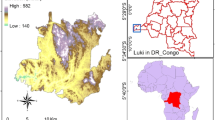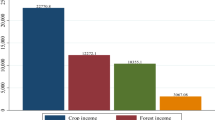Abstract
Local communities in central Brazil harvest buriti palm (Mauritia flexuosa) fruit from swamp forests as well as using them for agriculture and cattle and pig farming. This study describes the intensity of forest use by buriti fruit harvesters and identifies how their socioeconomic conditions influence resource use. We visited 75 swamp forests where buriti fruits are harvested and interviewed the head of the nearest household. Agriculture was practiced in 72 % of forests and cattle farming in 52 %. For almost half (48 %) of households agriculture and buriti fruit harvest were the main sources income. Forests resources were equally important to all socioeconomic classes, even richer farmers. The intensity of fruit harvest did not differ between collective and private use regimes of forests. Market access was a limitation to fruit harvest intensity. The high intensity of swamp forest use suggests that their conservation will require change to current management practices.







Similar content being viewed by others

Notes
Buriti fruits are also an important NTFP for people from other regions. For example, in the Peruvian Amazon near Iquitos, up to 40 % of households commercialize buriti fruits; which represent their third largest source of income after agriculture and fishing (Pyhälä et al. 2006), amounting to US$ 1,525 per ha.year−1 (Peters et al. 1989).
References
Adhikari, B., Di Falco, S., and Lovett, J. C. (2004). Household characteristics and forest dependency: evidence from common property forest management in Nepal. Ecological Economics 48: 245–257.
Aguiar, A. C. F., Freitas, I. C., Carvalho, C. S., Monroe, P. H. M., and Moura, E. G. (2011). Efficiency of an agrosystem designed for family farming in the pre-Amazon region. Renewable Agriculture and Food Systems 26(1): 24–30.
Babulo, B., Muys, B., Nega, F., Tollens, E., Nyssen, J., Deckers, J., and Mathijs, E. (2009). The economic contribution of forest resource use to rural livelihoods in Tigray, Northern Ethiopia. Forest Policy and Economics 11: 109–117.
Baird, I. G. (2010). Private, small groups, or communal: Dipterocarpus wood resin tree tenure and management in Teun Commune, Kon Mum district, Ratanakiri Province, Northeastern Cambodia. Society and Natural Resources 23: 1027–1042.
Balick, M. J. (1979). Economic Botany of the Guahibo. 1.Palmae. Economic Botany 33: 361–376.
Barham, B. L., Coomes, O. T., and Takasaki, Y. (1999). Rain forest livelihoods: income generation, household wealth and forest use. Unasylva 198: 71.
Basurto, X., and Ostrom, E. (2009). The core challenges of moving beyond Garrett Hardin. Journal of Natural Resources Policy Research 1: 255–259.
Bista, S., and Webb, E. L. (2006). Collection and marketing of non-timber forest products in the far western hills of Nepal. Environmental Conservation 33: 244–255.
Coomes, O. T., Barham, B. L., and Takasaki, Y. (2004). Targeting conservation–development initiatives in tropical forests: insights from analyses of rain forest use and economic reliance among Amazonian peasants. Ecological Economics 51: 47–64.
Davidar, P., Arjunan, M., and Puyravaud, J. P. (2008). Why do local households harvest forest products? A case study from the southern Western Ghats, India. Biological Conservation 141: 1876–1884.
Davidon-Hunt, I., Duchesne, L. C., and Zasada, J. C. (2001). Non-timber forest products: local livelihoods and integrated forest management. In Davidon-Hunt, I., Duchesne, L. C., and Zasada, J. C. (eds.), Forest communities in the third Millennium: linking research, business, and policy toward a sustainable non-timber forest product sector. United States Department of Agriculture (USDA) General Technical Report NC-217, St. Paul, p. 151.
De Beer, J. H., and McDermott, M. (1989). The economic value of non-timber forest products in South East Asia. The Netherlands Committee for IUCN, Amsterdam.
Dietz, T., Dolsak, N., Ostrom, E., and Stern, P. C. (2002). The drama of the commons. In Ostrom, E., Dietz, T., Dolsak, N., Stern, P. C., Stonich, S., and Weber, E. U. (eds.), The dramas of the commons. National Academy Press, Washington.
Edwards, D. M. (1996). The trade in non-timber forest products from Nepal. Mountain Research and Development 16: 383–394.
Feeny, D., Berkes, F., McCay, B. J., and Acheson, J. M. (1990). The tragedy of the commons: twenty-two years later. Human Ecology 18: 1–19.
Fisher, R., Maginnis, S., Jackson, W. J., Barrow, E., and Jeanrenaud, S. (2005). Poverty and conservation: landscapes, people and power. IUCN, Gland, Switzerland and Cambridge, UK.
Gavin, M. C., and Anderson, G. J. (2007). Socioeconomic predictors of forest use values in the Peruvian Amazon: A potential tool for biodiversity conservation. Ecological Economics 60: 752–762.
Ghate, R., Mehra, D., and Nagendra, H. (2009). Local institutions as madiators of the impact of markets on non-timber forest product extraction in central India. Environmental Conservation 36(1): 51–61.
Godoy, R., Brokaw, N., and Wilkie, D. (1995). The effect of income on the extraction of non-timber tropical forest products: model, hypotheses, and preliminary findings from the Sumu Indians of Nicaragua. Human Ecology 23: 29–52.
Govender, N., Trollope, W. S. W., and Van Wilgen, B. W. (2006). The effect of fire season, fire frequency, rainfall and management on fire intensity in savanna vegetation in South Africa. Journal of Applied Ecology 43: 748–758.
Gragson, T. L. (1995). Pumé exploitation of Mauritia flexuosa (Palmae) in the Llanos of Venezuela. Journal of Ethnobiology 15: 177–188.
Hardin, G. (1968). Tragedy of Commons. Science 162: 1243–1248.
Hegde, R., and Enters, T. (2000). Forest products and household economy: a case study from Mudumalai Wildlife Sanctuary, Southern India. Environmental Conservation 27: 250–259.
Hegde, R., Suryaprakash, S., Achoth, L., and Bawa, K. S. (1996). Extraction of non-timber forest products in the forests of Biligiri Rangan Hills, India. 1. Contribution to rural income. Economic Botany 50: 243–251.
Holm, J. A., Miller, C. J., and Cropper, W. P. (2008). Population dynamics of the dioecious Amazonian palm Mauritia flexuosa: simulation analysis of sustainable harvesting. Biotropica 40: 550–558.
Horn, C. M., Gilmore, M. P., and Endress, B. A. (2012). Ecological and socio-economic factors influencing aguaje (Mauritia flexuosa) resource management in two indigenous communities in the Peruvian Amazon. Forest Ecology and Management 267: 93–103.
Kahn, F. (1991). Palms as key swamp forest resources in Amazonia. Forest Ecology and Management 38: 133–142.
Kato, M. S. A., Kato, O. R., Denich, M., and Vlek, P. L. G. (1999). Fire-free alternatives to slash-and-burn for shifting cultivation in the eastern Amazon region: the role of fertilizers. Field Crops Research 62: 225–237.
Legendre, P., and Legendre, L. (1998). Numerical ecology, 2nd ed. Elsevier Science, Amsterdan.
Lima, W. P., and Zakia, M. J. B. (2000). Hidrologia de matas ciliares. In Rodrigues, R. R., and Leitão-Filho, H. F. (eds.), Matas ciliares: conservação e recuperação. Editora da Universidade de São Paulo: Fapesp, São Paulo, pp. 33–44.
Manzi, M., and Coomes, O. T. (2009). Managing Amazonian palms for community use: a case of aguaje palm (Mauritia flexuosa) in Peru. Forest Ecology and Management 257: 510–517.
Marinho-Filho, J., and Gastal, M. L. (2000). Mamíferos das matas ciliares dos Cerrados do Brasil central. In Rodrigues, R. R., and Leitão-Filho, H. F. (eds.), Matas ciliares: conservação e recuperação. Editora da Universidade de São Paulo: Fapesp, São Paulo, pp. 209–221.
Marshall, E., and Newton, A. C. (2003). Non-timber forest products in the community of El Terrero, Sierra de Manantlan Biosphere Reserve, Mexico: Is their use sustainable? Economic Botany 57: 262–278.
Marshall, E., Newton, A. C., and Schreckenberg, K. (2003). Commercialisation of non-timber forest products: first steps in analysing the factors influencing success. International Forestry Review 5: 128–137.
Narendran, K., Murthy, I. K., Suresh, H. S., Dattaraja, H. S., Ravindranath, N. H., and Sukumar, R. (2001). Nontimber forest product extraction, utilization and valuation: a case study from the Nilgiri Biosphere Reserve, southern India. Economic Botany 55: 528–538.
Nascimento, A. R. T., Santos, A. A., Martins, R. C., and Dias, T. A. B. (2009). Palm communities in the Kraho indigenous territory, Tocantins, Brazil: biodiversity and ethnobotanical features. Interciencia 34: 182–188.
Ostrom, E. (1990). Governing the commons. The evolution of institutions for collective action. Cambridge University Press, Cambridge.
Ostrom, E., Burger, J., Field, C. B., Norgaard, R. B., and Policansky, D. (1999). Revisiting the commons: local lessons, global challenges. Science 284: 278–282.
Pandit, B. H., and Thapa, G. B. (2003). A tragedy of non-timber forest resources in the mountain commons of Nepal. Environmental Conservation 30: 283–292.
Paumgarten, F., and Shackleton, C. M. (2009). Wealth differentiation in household use and trade in non-timber forest products in South Africa. Ecological Economics 68: 2950–2959.
Peters, C. M., Balick, M. J., Kahn, F., and Anderson, A. B. (1989). Oligarchic forests of economic plants in Amazonia: utilization and conservation of an important tropical resource. Conservation Biology 3: 341–349.
Pyhälä, A., Brown, K., and Adger, W. N. (2006). Implications of livelihood dependence on non-timber products in Peruvian Amazonia. Ecosystems 9: 1328–1341.
Sampaio, M. B., Schmidt, I. B., and Figueiredo, I. B. (2008). Harvesting effects and population ecology of the buriti palm (Mauritia flexuosa L. f., Arecaceae) in the Jalapão region, Central Brazil. Economic Botany 62: 171–181.
Santos, R. S., and Coelho-Ferreira, M. (2012). Estudo etnobotânico de Mauritia flexuosa L. f. (Arecaceae) em comunidades ribeirinhas do Município de Abaetetuba, Pará, Brasil. Acta Amazônica 24(1): 1–10.
Schmidt, I. B. (2011). Effects of local ecological knowledge, harvesting and fire on golden-grass (Syngonanthus nitens, Eriocaulaceae), a non-timber forest product (NTFP) species from the Brazilian savanna. PhD Thesis, Botany department, University of Hawai’i at Manoa, Honolulu.
Schmidt, I. B., Figueiredo, I. B., and Scariot, A. (2007). Ethnobotany and effects of harvesting on the population ecology of Syngonanthus nitens (Bong.) Ruhland (Eriocaulaceae), a NTFP from Jalapão region, central Brazil. Economic Botany 61(1): 73–85.
Schmitz, H., Mota, D. M., and Júnior, J. F. S. (2009). Gestão coletiva de bens comuns no extrativismo da mangaba no nordeste do Brasil. Ambiente & Sociedade 12: 273–292.
Shackleton, C., Delang, C. O., Shackleton, S., and Shanley, P. (2011). Non-timber forest products: concept and definitions. In Shackleton, S., Shackleton, C., and Shanley, P. (eds.), Non-timber forest products in the global context. Springer, Berlin, Heidelberg, pp. 3–21.
Shackleton, C., and Shackleton, S. (2006). Household wealth status and natural resource use in the Kat River valley, South Africa. Ecological Economics 57: 306–317.
Shanley, P., Luz, L., and Swingland, I. R. (2002). The faint promise of a distant market: a survey of Belem’s trade in non-timber forest products. Biodiversity and Conservation 11: 615–636.
Shepherd, G. J. (2006). FitopacShell 1.6.4. Manual versão preliminar. Departamento de Botânica, Universidade Estadual de Campinas, Campinas.
Silva-Filha, O. L., Filho, E. C. P., Souza, J. F., Oliveira, A. S., Oliveira, R. J. F., Melo, M., Melo, L. M., Araújo, K. A. O., and Sereno, J. R. B. (2008). Caracterização do sistema de produção de suínos locais na microrregião do Curimataú Paraibano. Revista Brasileira de Saúde e Produção Animal 9: 7–17.
StatSoft, Inc. (2004). STATISTICA (data analysis software system), version 7. www.statsoft.com.
Storti, E. F. (1993). Biologia floral de Mauritia flexuosa Lin. Fil, na região de Manaus, AM, Brasil. Acta Amazônica 23: 371–381.
Tabachnick, B. G., and Fidell, L. S. (2001). Using multivariate statistics, 4th ed. Allyn & Bacon, Boston.
Toniato, M. T. Z., Leitão-Filho, H. D. F., and Rodrigues, R. R. (1998). Fitossociologia de um remanescente de floresta higrófila (mata de brejo) em Campinas, SP. Revista Brasileira de Botânica 21: 197–210.
Yang, X. F., Wilkes, A., Yang, Y. P., Xu, J. C., Geslani, C. S., Yang, X. Q., Gao, F., Yang, J. K., and Robinson, B. (2009). Common and privatized: conditions for wise management of matsutake mushrooms in Northwest Yunnan Province, China. Ecology and Society 14(2): 30.
Acknowledgements
We thank our field assistants I.M. Medri and A.P. Lopes; A. Scariot, I.B. Schmidt and A.B. Sampaio for helpful suggestions; I.B. Figueiredo who provided information about the study regions; all swamp forest owners and field guides for kindly sharing their knowledge and experience; CNPq (Proc. num. 472127/2008-0, M. B. Sampaio’fellowship num. 140813/2009-8, F. A. M. Santos’ fellowship num. 140813/2009-8, C. S. Seixas’ fellowship num. 308480/2009-0), FAPESP (Proc. num. 2008/08737-4), CAPES (M. B. Sampaio’fellowship), PPP-ECOS ISPN/GEF/PNUD (project BRA/04/21); and Idea Wild.
Author information
Authors and Affiliations
Corresponding author
Rights and permissions
About this article
Cite this article
Sampaio, M.B., Ticktin, T., Seixas, C.S. et al. Effects of Socioeconomic Conditions on Multiple Uses of Swamp Forests in Central Brazil. Hum Ecol 40, 821–831 (2012). https://doi.org/10.1007/s10745-012-9519-y
Published:
Issue Date:
DOI: https://doi.org/10.1007/s10745-012-9519-y



